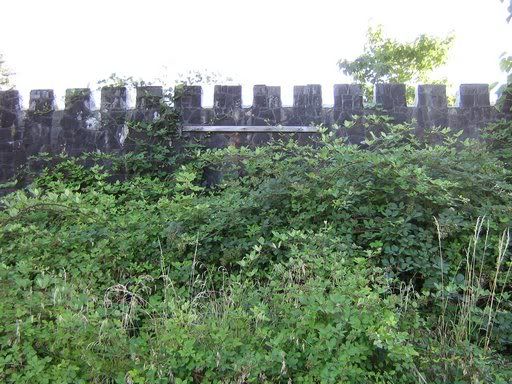Two Castles

During my teenage years a girl I knew told me of a ruinous castle hidden in Portland’s west hills. Over time I conducted various spontaneous searches for this building, but all went unrewarded. It wasn’t until I discussed this topic with the Portland Surrealist Group that I recovered any information. MK Shibek told me of seeing a band perform an acoustic set one night in the remnants of a stone house somewhere in the forest of the west hills. Morgan Miller confirmed that this was the structure I had been searching for, and provided a general idea of its location. Portland has its series of ruins, but this structure, which has been dubbed the Witch’s Castle, is by far the most popular. Located in MacLeay Park, a forested area in northwest Portland that runs along Balch Creek, this stone edifice can be reached after a half-mile walk along the creek bed. Enchanting, like something out of a fairy tale, the building’s two imposing walls rise out of the forest, each coming to a moss-covered point. Between the walls is a flat barren space, easily accessible by two irregular staircases. Below this space, at the base of the structure, are two mysterious, cavernous openings now housing beer cans and graffiti. The building served as a restroom from the 1930s until it was damaged in the Columbus Day storm of 1962. Today, covered with vegetation, its vestiges have a life outside the corporate world of the useful. A forgotten place, when left in a state of disrepair, takes on a curious ambiance, where the opposing terms of life and death appear to both struggle and harmonize. The natural world reclaims in a slow and violent way the space it once occupied, while decay, that lackey of time’s supremacy, can seem soluble in the midst of the Marvelous.
Not far from Portland in Gladstone, where Glen Echo Avenue meets River Road, is another stone ruin. Christened simply The Castle, this building, with its hand-cut stone and arches, was purposely crafted to appear medieval, yet instead of being surrounded by a moat it is now surrounded by a bundle of foliage. Along with a patchwork of moss, dark stains cover the brick walls, which are notched at the top in an attempt to give the building some antique legitimacy, but these notches appear more comical than historical. The rear of the structure, mostly made of wood, is covered with graffiti and large planks are spread out around the back parking lot as if part of the building had recently been dismantled. Built by a French stonecutter, the building was originally a tavern in the 1930s. In the 1940s it became home to Castle Records and the Castle Jazz Band, a touted, white musical troupe that specialized in the jazz of the early 20th century, such as the music of Jelly Roll Morton and King Oliver. Growing up in this region I have vague memories of this structure as a restaurant, yet these days it seems to serve a far greater purpose: as a token of a more colorful time in a region now dominated by used car lots and fast food chains.
Brandon Freels